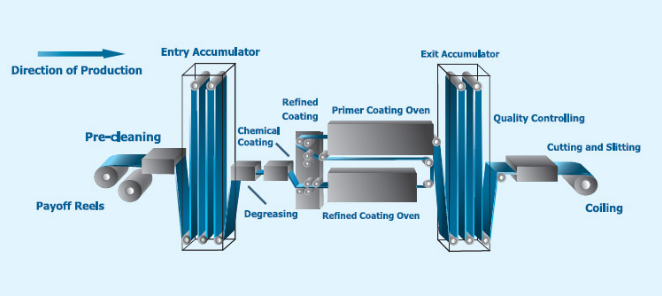PPGI sheet is the ultimate product for deep processing of sheet metal by steel companies in the world today. It has the characteristics of lightweight, beautiful appearance and good corrosion resistance, and is widely used in construction, light industry, home appliances, and other industries.
In recent years, with the development of these industries and the improvement of consumption levels, their market demand has grown rapidly, which has attracted a large number of domestic and foreign companies to build or are building color-coated board production lines.
PPGI Main Products and Applications
PPGI products mainly include polyester, silicon modified polyester, epoxy resin, fluorocarbon, acrylic resin, plastic melt adhesive, household appliance polyester, surface film, embossing, and other products. The finished product specifications are generally: thickness 0.3~1.6mm, width 750~1350mm, coating thickness 2.5~200μm, finished roll weight 3~10t.
In the production of color-coated panels, the construction industry is the largest demand area for color-coated panels. All kinds of buildings, including warehouses, supermarkets, stations, airports, stadiums, commercial buildings, residential buildings, etc., require color-coated steel plates, which are mainly used to produce corrugated boards, sandwich panels, doors, and windows, etc.
The thickness specifications of the color panels required for residences, doors, and windows are 0.7mm and 0.8mm; the thickness specifications of color panels required for the movable houses and factories are 0.4mm, 0.5mm, 0.6mm, etc.
The color-coated panels used in the home appliance industry are mainly coated color panels (PVC), which are mainly used for eye-catching shells such as refrigerators, freezers, washing machines, disinfection cabinets, microwave ovens, DVD players, and high-end decorations.
PPGI Main Production Process
During production, use a crane to hoist the raw material coils on the receiving table of the color coating unit, and then transport the steel coils to the coil seat in front of the color coating unit by a transport trolley, remove the straps here, and then load the trolley The raw steel coil is loaded onto the uncoiler, and the strip head is automatically guided to the cutting head by the tape guide device. The strip is sewn with the previous coil at the sewing machine.
The stitched steel strip first enters the pre-cleaning section for alkaline water washing, alkaline water scrubbing, and hot water washing, and then it is dried by hot air and enters the looper. After the looper, it enters the pre-treatment section and performs alkaline water in the pretreatment section.
Rinse, alkaline water scrubbing, two-stage hot water flushing, then conditioning treatment and two-stage hot water flushing, and then hot air drying, enter the chemical coating machine, apply a layer of water-based chromium to the surface of the strip, and then After the chemical coating machine, enter the hot air dryer for drying.
The water-cooled roller arranged behind the hot air dryer cools the strip steel to below 40°C, enters the roller coater for primary coating, and then enters the pendant curing oven for drying. The pendant curing oven is equipped with sag detection. Out curing
The strip steel in the furnace has a temperature of 260°C, enters the water quenching tank, is dried by air, and then enters the fine coating machine through the turning roller for fine coating, and then enters the fine coating curing oven to dry the paint.
Such as the production of hot film board, the strip steel out of the curing furnace needs to be quenched, the temperature is reduced to a certain temperature and then enters the hot film machine, the strip steel out of the film machine is cooled in the water quenching tank, and then dried.
The strip steel enters the exit looper, passes through the inspection table and exit shears, the strip steel is cut into required small coils, and then the finished coils are transported to the export coil seat by the unloading trolley. The finished product rolls are sent to the packaging unit with a workshop crane for packaging and then sent to the finished product warehouse for storage.
PPGI Pre-treatment Process
The main purpose of the pre-treatment process is to remove grease and impurities on the surface of the strip steel, and through passivation, form a chemical conversion film on the surface of the steel plate to improve the adhesion and stripping between the coating and the strip steel substrate.
Steel corrosion resistance. The pre-treatment process is:
Degreasing → Brushing → Hot water washing → Surface adjustment → Hot water washing → Passivation → Drying
Surface adjustment is a surface treatment process added before phosphate or chromate treatment in the production of certain products.
Use a weakly acidic agent containing Ni and F ions to spray the surface of the strip steel, the purpose of which is to improve the coating performance and the adhesion of the coated passivator, and to remove the precipitation of Al and the grain boundary on the surface of the galvanized substrate. Pb and other substances, this process is especially represented by Japan.
Passivation usually requires the use of phosphate or chromate to treat the substrate. The main passivation methods include spray, immersion, and coating.
